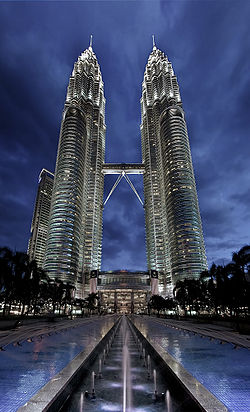by Larry
December, 2010A Tall Tale About Food
Farming via agricultural land, the thesis goes, is far too impractical a way of getting essential foodstuffs for an ever growing populace. Instead, to save on the fuels and its pollution needed to transport basic edible commodities to where people will consume them, we need the source of foods to be right where most people in the world are currently residing, inside the cities. For this purpose, roof gardens and farms are still rather small fry ventures. We must think much, much bigger. A modern farm, even ramped up with tons of fertilizer, for all its use of land, on average produces only about one-fifth to one-sixth the potential crop yield of a multi-story indoor farm. Consider that most farm acreage only permits one harvest a year. The same crop raised inside could complete 6-8 start-to-finish agricultural cycles annually, greatly multiplying the yield and profits. Imagine a world in which a gallon of gasoline costs $10 or more, in which 60-70% of us live in large metropolitan areas, in which atmospheric and runoff pollution costs are factored into the overhead of maintaining distant farm acreages, in which, due to droughts and heat waves, global warming has rendered many of the world's usual breadbaskets untenable, and yet in which as well the architectural engineering is there for massive environmentally controlled skyscrapers, for production year-round, for hydroponics systems' greater crop efficient, for wastewater recycling, for solar energy replacement of much of the old fossil fuel demands of "flat farming," for digitally automated systems minimizing the overall energy consumption, and for crops being nurtured in jungle-like, growth enhancing water saturated atmospheres. What may seem today a futuristic fantasy could be the economic necessity and reality of a half-century from now, when energy is more expensive, effects of various kinds of pollution are more dramatically apparent, and population projections are in excess of 9 billion. Barring a catastrophe in our species' evolving development of Earth's surface, chances are the question is not if but when skyscraper farms take hold in a major way. We are as yet probably at the stage of Model T Fords in seeing the fruition of this technology. Once we reach that of the Prius or other more efficient hybrid or even hydrogen powered vehicles, millions of square miles of presently agricultural lands may be freed up for better uses, maybe becoming vast grasslands or forests once more, and so removing net carbon from the atmosphere rather than adding to it. I shall not hold my breath, but it could definitely happen. Meanwhile, which of the globe's mega-cities, perhaps for a latter 21st Century World's Fair, will be the first to create a practical vertical farm model? Primary Source: Urban Farming. Meghan Casserly in Forbes Magazine, Vol. 186, No. 11, pages 88-89; December 20, 2010. |
